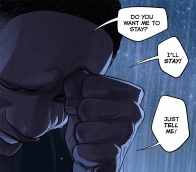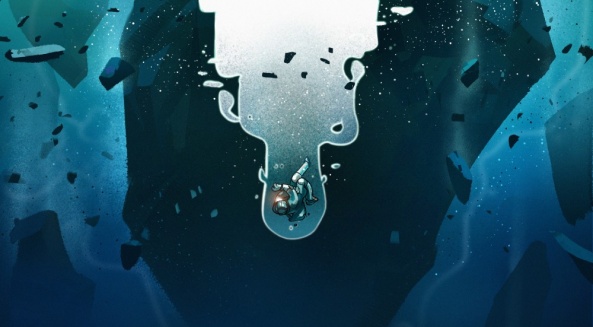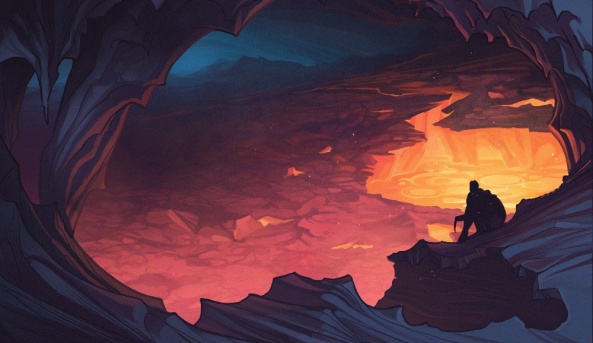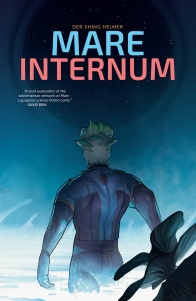The webcomic creator is never far from their audience. Be it through social media, public email addresses, Discord servers, or simply the comments section beneath a page, there is a rapport and a conversation that is developed that is unique to the medium. We’re continuing those conversations here, albeit a little more formally, by interviewing webcomics creators to pick their brains about craft, storytelling, and their personal experiences with the medium.
After our special additional interview last month with Valerie Halla, we’re back to our regular every other month interview schedule with a creator who needs little introduction: Eisner-nominated and Ignatz award winner, Der-shing Helmer. Long-time interview readers might remember her name being dropped by Petra Nordlud (“Tiger, Tiger”) and Blue Deliquanti (“O Human Star”). The lead editor on “Electrum,” the first of the Alloy anthology series, and creator of “The Meek” and “Mare Internum,” Der-shing is no stranger to the trials and tribulations, as well as the wonders, of the webcomics world.
But why take my word for it? Let’s let her do the talking instead!
Tell us about your experiences with webcomics prior to starting “The Meek” and “Mare Internum?”
The first thing I did when I got the internet, in 1997, was look for the fringiest stuff I could find. At the time people were just signing on, and I was 13, so of course I looked at a bunch of horrible unmentionable sites first, but I soon found the subculture pages, which had a very strong art/comics component. From there I continued to read comics on Keenspot, Girlamatic, the early hosting sites of the day, and found a bunch of artists who are all highly advanced now, haha, but started off by posting their rough work on small personal sites. So I’ve been reading webcomics for about as long as I’ve been online, and had always wanted to make one.
For a while, you were updating these two comics at once. Did you find it rejuvinating to swap between projects or was it more of a drain?
It was partially a matter of necessity, what with falling into some legal issues with “The Meek” a few years ago. I unexpectedly got my rights back around the time I started “Mare,” so suddenly I found myself having to update two comics at once instead of just the one. I personally wouldn’t recommend it with two projects with such tonal differences; I found it very uncomfortable trying to mentally jump from comedic adventures to depressing body horror within the space of a few hours, and eventually had to stop completely in order to not completely mess up both projects at once.
Did you find it more uncomfortable to jump from one to the other?
Yes, it was definitely a pain in the ass to jump from “Mare” to “Meek.” At the time (and currently, to be honest), I wasn’t in a great place. When I started making “The Meek” I was very fresh, out of college and scrappy and hit in the face by the recession at the time, but in a sort of “what do I have to lose” mindset that let me put everything into a project I wasn’t being paid for, since it was the only outlet I had. I did (and still do) use humor to get myself through hard times, but there’s a point when things get too serious to laugh at.

“Meek” is something I love to work on when the pain is manageable, but when it isn’t and I’m just stuck in an emotional cave, I want to work on darker comics and channel my feelings into more subtle emotions, painful conversations I’m already having with myself in the shower, that kind of thing. Jumping back into this lighter, more broadly conceptual adventure, is very difficult to do when your liver is like, currently being torn out by eagles.
Part of me worries that the most recent chapters of “The Meek” are too dour in undertone because I was trying hard to fake that springy base layer, but oh well. Maybe that’s just who I am now.
You also are an editor on the Alloy Anthology project. What is it like to be in an editorial position for the project?
Continued belowIt was interesting for sure; Alloy is my first self-run anthology (concept, production, team management, editing, etc). To some extent, I pulled from my experiences working with other editors on anthologies I’d been involved with in the past — what I liked and didn’t like from those projects. The big change was that I’m really only used to working with myself (on comics– I’ve run teams before for other productions). For comics, I prefer to do everything alone, and didn’t want to bring that mindset into working with others. I did my best to let the voices of the artists and writers involved to come through naturally without imposing my own thoughts unless it was vital. I am still terribly grateful to Kiku Hughes for assisting on the editing; she is an incredibly thoughtful and precise writer, and working with her was a way for me to allay my fears that I was perhaps overthinking or overstepping any of the content editing we did on the stories. I’m really proud of the work that the team put out together.
Any lessons you can impart on future editors and/or contributors to anthology projects that you’ve learned throughout the process?
Yes, definitely to work your way broad to large. Start with the message you want to send, the big-picture branding, the immediate feel you want people to have when they see the final product for the first time.
For “Electrum,” I wanted everything in the book to be own-voices work, I wanted the theme of mixing to be carried through in color scheme and even page and comic layout, I wanted to incorporate as many first-time artists as I possibly could, and I wanted everything about the book to feel fresh and uplifting. You can hopefully see that intent on every page of the book. I’ve seen a lot of great concepts that had a weak physical product, or beautiful books with questionable motivations, that sort of thing. . .also with Alloy, I had at least two other anthologies straight up steal my formatting, which can never happen if you’re designing your project top down — it only happens when you’re constructing your work desperately as you go. That’s not fair to the project owners or the readers. Every reader wants to see love and care and a story that gives them a new perspective. Anthologies can achieve that simply through the range of voices and editing. If you start with a solid foundation, it is so much more likely you’ll be able to achieve a solid final book.
Do you work digitally, physically or a combination of both? What about your preferred format do you find works best for you?
I’m a wholly digital artist for my “final” comics, though I still build stories and take notes physically/ traditionally. Part of me wishes I could do traditional “finished” art, but I’m horribly uncoordinated and didn’t have any formal art training, where I assume they teach you how to use the materials? I don’t know. I usually can picture the final product in my head before I start, and it’s frustrating to make something on paper that is uncorrectably different from the original vision. I also get anxious about wasting materials, having to buy paper, pens, etc. . .I’m a bit of a shut-in and fairly miserly as well, haha, so digital really does afford a lot of freedom to create whatever you want, after the initial investment. You sacrifice some satisfaction maybe, or open yourself to repetitive injuries or eyestrain, but comics tends to be painful work no matter what medium you work in.
That’s something I hear a lot from webcomic creators, that the magic of digital is the ability to fine tune in a way that isn’t available to ink and brush and pen and paper. Have you ever gotten lost in the process of editing smaller and smaller aspects of your comics?
Thankfully no, because I’m lazy, lol. Before I start a project, I’ll define my mins and maxes so I don’t get too lax or too carried away. I’ll know that I should stop drawing at a certain amount of detail, or lines on the face, or background information. I try to avoid things like leaving backgrounds blank for example, but I will reduce them at times if the focus is more important than the setting. The overall goal of a page is to communicate story; sometimes that means action, sometimes it’s words, sometimes it’s an emotion. The presences of detail is adjacent to fulfilling the main goal of nuanced, consistent visual communication.
Continued below
What have you found to be the most challenging part of the creation process? Is it the idea generation, the scripting or is it a function of the art, or the lettering?
Lately, it’s been trying to immerse myself in a false world while the real world is beating down on me. Unfortunately the last few years have been really rough– a lot of big life changes, traumatic events, deaths. My mother is currently dying of a terminal disease and it’s nearly impossible to allow myself the luxury of escapism when there’s so much pain and suffering around me. The rest of it is almost inconsequential by comparison.
Ridiculously, I’m bursting with ideas right now. But the act of picking up a tablet pen has come to represent something it never did for me before, which has arrested my ability to create in the volumes and with the voice I used to take for granted. I can feel the urge to create straining against this skin that’s formed over my life though, so I’m sure it’ll burst through regardless at some point. Whatever comes out will likely be just as strange and terrible as the last few years has been to me, and to be honest I’m looking forward to seeing it.
Do you ever think about putting those ideas to paper (or screen, as it were) for yourself, with no intention to share? Or do they just live in your head, waiting for the moment to be released on an unsuspecting public?
Sadly, I’m trapped in a cycle of needing to share things! I think I only make comics to communicate, since I’m not terribly good at it in real life… not a ton of close friends, a lot of complicated situations in my life that are awkward to talk about, etc. So keeping those things to myself, after being refined onto a page, doesn’t do much to achieve my goals for making comics in the first place. I wish I was one of those people who simply draw for fun or stress relief but alas! the act of sharing thoughts is important to me too, haha.
Frequent, lengthy hiatuses chased both series over the years. What prompted them and what helped bring you back to the stories?
Mostly what I just mentioned. There’s chronic illness in my family, it’s not really understandable to people who don’t have experience with it, but sometimes I am not able to work because I need to attend to someone else. I’ve had a lot of setbacks legally being taken advantage of by unscrupulous people. I’ve had to increase the scope of my business from simply sitting at a table and drawing to becoming a one-person production and distribution team. I’m wholly responsible for my own marketing and research and fixing my printer when it breaks (still broken) and warehousing and dragging myself to conventions and making my budget balance at the end of the month and all that good stuff. Fielding questions from people yelling about where did I go when I’m barely hanging on, and having a hard time answering that question for myself. It’s a lot of work and a lot of time spent doing things other than comics, that has to be done in order for me to do the comics. . .but from experience, things usually do hit a lull at some point? And then the creation begins again.
Did it ever get to the point where the length of the hiatus became the problem preventing you from ending the hiatus, mentally?
Not really, though it’s an interesting question. I hate being on hiatus. The only problem I’ve had with ending one is making sure that the folks who were waiting on you get to see that you are now active again. Generally speaking, I am raring to get back to posting (the stories are often “complete” in my head, so the bulk of the fun for me is in sharing them,) but social media algorithm changes, and of course audience loss, is difficult to navigate at times. I have multiple thousands of followers across several platforms, but oftentimes I’m not sure I’m even reaching a fraction of them anymore. So when I’m ready I’m usually fully ready, but I still get people at conventions who used to follow religiously and had no idea there are more chapters (or even an entire new comic) now available for them to look at online.
Continued belowMoving to “Mare Internum,” what was it about Mars that appealed to you as a setting?
Mars is rad. And red. But mostly rad.
But for reals, because it’s our neighbor, and within view, and reach, and of course that makes it romantic. Also giant volcanoes. And the giant canyons and sweeping plains. There’s nothing I don’t like about Mars.

Can you give us a really cool Mars fact that few people know and/or wasn’t able to make it into the comic?
Oh boy I did try to get most of them in there. Additionally, a lot has changed since I started writing it (for example: internal seas are actually confirmed now!) But one cool fact is that the Martian sky is actually gray-blue, not red. The reddish tinge we all see in photos are either color corrected, or indicative of particulates in the atmosphere which are both red/ suspended, and reflecting the blue light away. In the comic, I made the (clear) sky yellow/ reddish at times just cuz of those sweet artsy vibes, but in “reality” it probably would be much more washed out and desaturated.
The creature designs are this beautiful mix of alien and familiar. What was the source material that inspired them and could you walk me through a quick example of the process?
The creatures in Mare were a result of a lot of noodling about the setting, the messages, and simply what is fun to draw or not draw. Kallakore in particular was humanoid, originally, until I decided there was no way to make a humanoid alien that didn’t feel campy. In fact, I am not entire sure there is any way to make a talking alien that doesn’t feel campy. As soon as understandable language comes out of an extraterrestrial in a film at least, I tend to stop taking it seriously. But I figured I’d be able to minimize the effect by reducing the amount of facial expressiveness, which of course is the wheelhouse of reptiles and aquatic animals. Very hard to empathize with a blank shark face, so the weight of the emotionality can be foisted instead onto the body language and dialogue.
Initially, I was unsure if Kallakore would be friend or foe, so her body is large and gorilla-like to give a threatening physicality. And then the unbalanced legs for a purely “alien” look, since extant animals don’t really walk like that on Earth any more (Pterosaurs probably had a similar look though). And of course adding elements of the aquatic vibe as much as possible: the finlike head crest, the crabs and worms and insects everywhere, spindly animals that would work better underwater or in low gravity than on terrestrial Earth, etc. It was a very fun and organic process.
What about Michael’s journey in “Mare Internum” necessitated him being the near sole focus of the book, rather than the ensemble approach you take to “The Meek?”

All of my stories are soapboxes to some degree; “The Meek” is mainly about what the role of humanity is to the world, and obviously there’s a lot of thoughts to explore there. “Mare” had a much more reduced scope, which was simply, what do you do about a mentally ill person? Someone who is superficially functional but collapsing on the inside? This reduced scope was mostly because I was trying to answer the question for my own benefit, not to answer it for anyone else (though by posting online, I intentionally welcomed the reader to relate or not relate). So Mike was my subject who I used to try and answer this question, a selfish and imperfect person unable to stop themselves from causing damage to their future due to their own problems. Bex was the role of the non-Mike or outsider, someone who cares deeply, but has their own life and important internal struggles to contend with. It is pretty simplistic when laid out this way, but it still took a while to answer my question, using these characters and this story, in a way that felt authentic.
Speaking of “The Meek’s” ensemble, the chapter by chapter, character split, is reminiscent of door stopper fantasy novels, and a fantastic way to section off multiple competing plotlines. Why was this the approach you chose to take?
Continued belowEmbarrassingly, I decided on this approach in my college days, the early 2000’s, after I’d read an obscure little novel called “A Game of Thrones.” At the time, I was quite inspired by GRRM’s interesting choice to split storylines, and thought nobody would ever figure out the reference, ahaha. It was also a choice of necessity, as I’d been working on three separate stories at the time- one about a werewolf dictator, one about a jungle child with the power to grow vines, and another about a space-faring bandit. Separately, each story had very little room to expand, but then it occurred to me that there was a way to tweak the storylines to come together eventually, under one roof, with a little bit of editing. That took a few years to work out (and a lot of work got thrown away in the process), but boy howdy, once they all meet up in the main comic, several decades from now at this point, won’t it all have been worth it?
What is that thing on Pinter’s head? Is it a Yarmulke?
Haha, something similar. In the original iteration of “The Meek,” the one that focused only on Angora, she was the mammal representative. There were 3 other characters; one based on a fish (she is now the Princeps of Citeran and mostly unrecognizable), one based on a bird (lost to the ages) and one based on a reptile, a terrapin turtle. Rearranging the name a bit got me to Pinter, and the hat is a holdover of the shell that originally represented the turtle look. It got co-opted into a religious hat which a few other characters wear in the comic as well.
Do you have the politics and institutions of the world mapped out or codified in more detail beyond what we’ll get in the comic or is it only those aspects that matter? Which I guess is both a practical and philosophical matter.
To some extent, yes. Due to the length of time it takes me to write, I often have time to make organic changes as I slowly radicalize further, haha. I started writing The Meek in earnest while at Berkeley, and I’m still a little more extreme (privately) than some of my acquaintances when it comes to certain things politically and philosophically. It’s also important to me to not cartoonify the situations in the comic too much. To some degree, there is a relaxed sense of world building that I choose not to expound on simply because I think that is bad writing, but in my opinion it’s just as bad to under-build and let the fantasy world reflect the real world in obvious ways. So yes, there will be more in the comic, but it might take a while for all of it to come out, and it might not be exactly what I have in mind right now when I finally do get around to those sections.
To close us out, what are three webcomics you would recommend for fans of “The Meek” and/or “Mare Internum?”
Oh boy, my favorite part. I absolutely recommend Lora Merriman’s incredible sci-fi comic The Otherknown, it’s one of my top favorites for art and audacious story. I can’t say enough good things about Vainglorious by Kelly Bull, fantastic characters, fantastical environments, and gripping story, like all webcomics should have. And it’s very difficult to choose just one more, but to be true to the ask, probably Everblue. Gorgeous and often overlooked by reviewers for some reason, but very likely an adventure comic that a lot of readers who enjoy my work would love as well.






